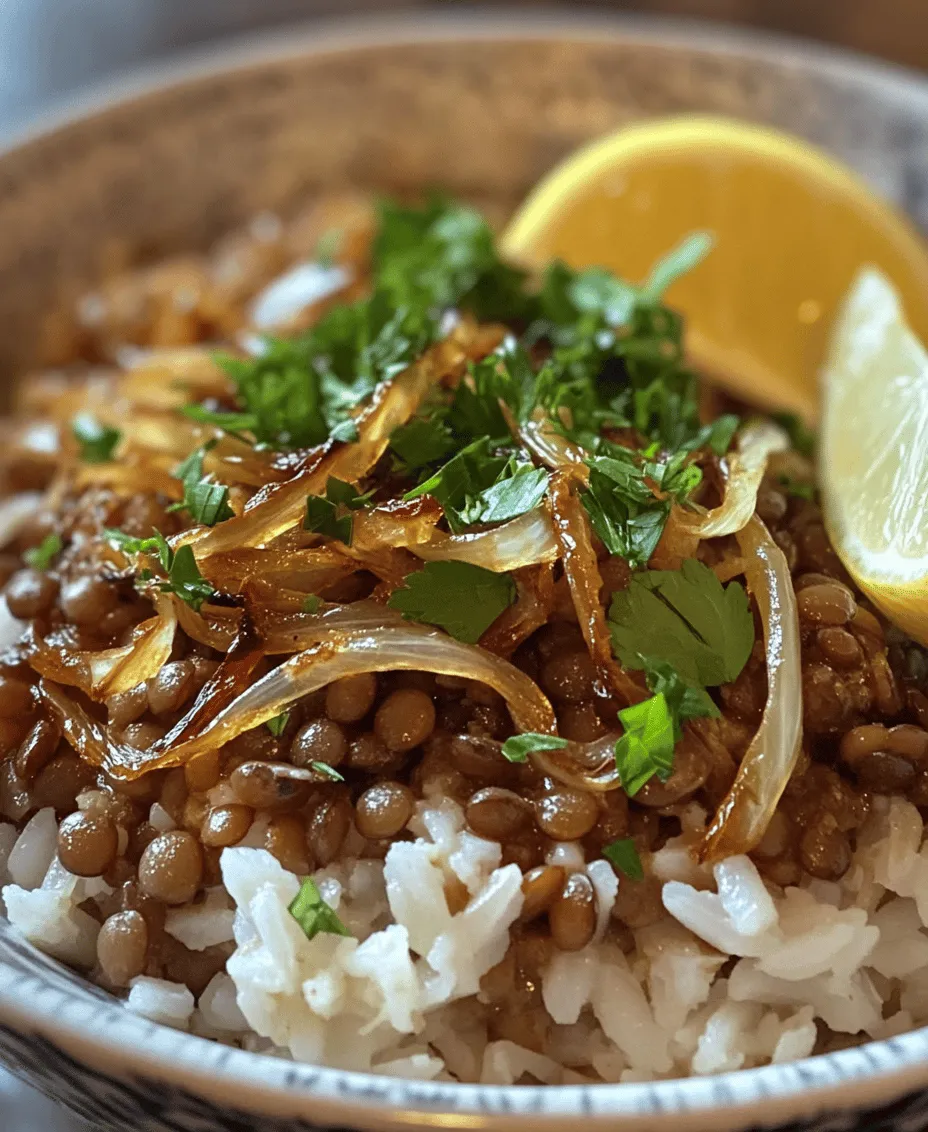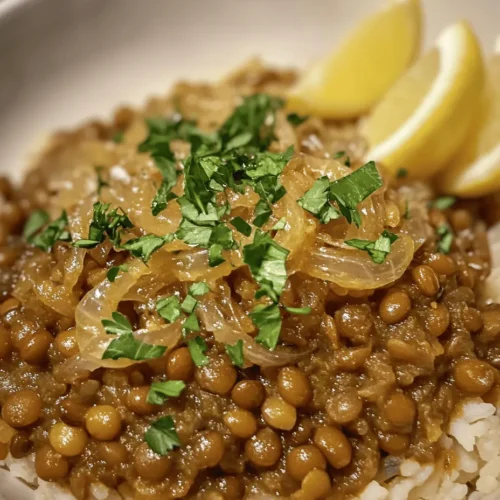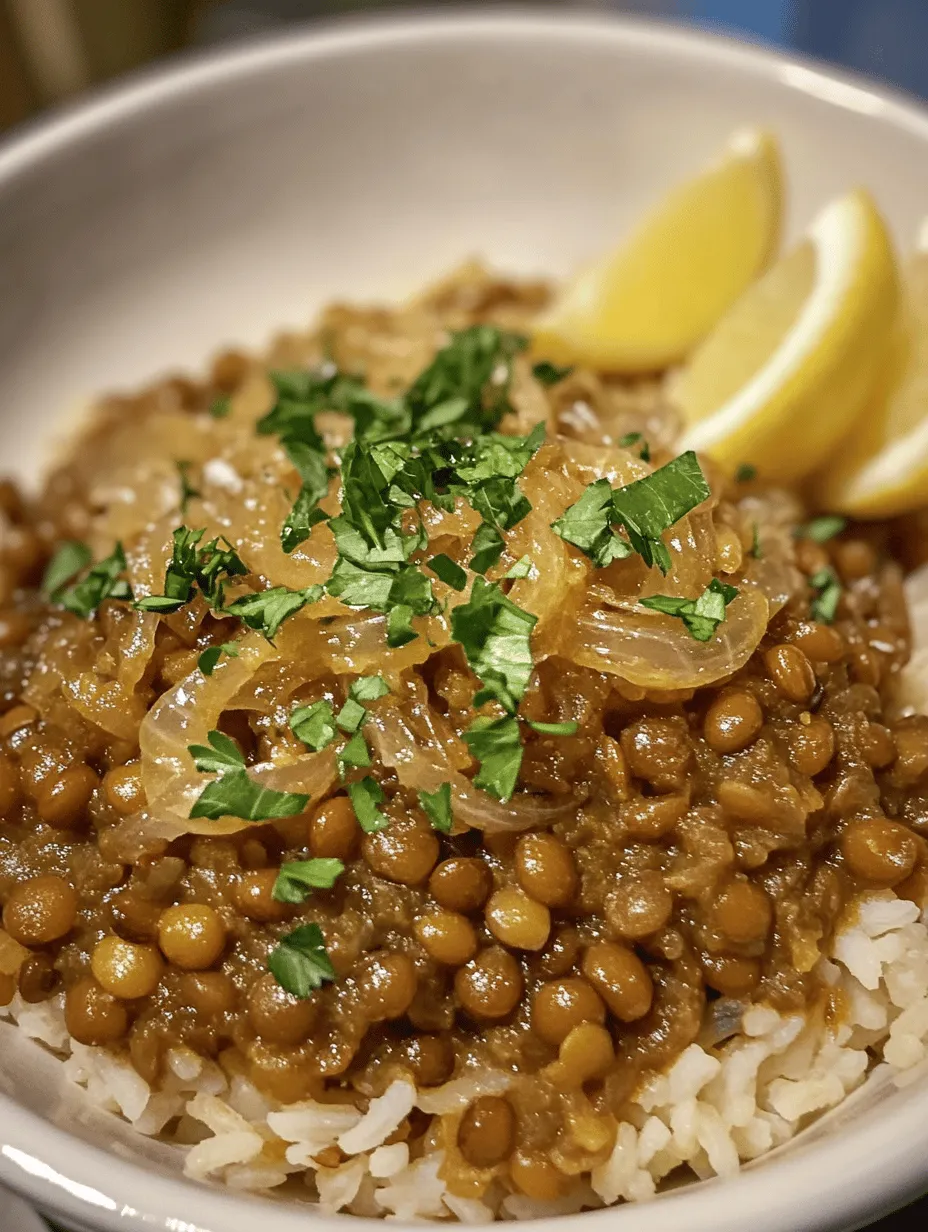Introduction
Mujadara, a traditional Middle Eastern dish, embodies the essence of comfort food with its simple yet flavorful ingredients. This beloved recipe features a delightful combination of brown lentils and long-grain rice, often topped with richly caramelized onions that lend a sweet, savory depth to the dish. Mujadara is not only a staple in many households across the Middle East but also a favorite among those exploring plant-based diets, thanks to its wholesome ingredients and satisfying flavors.
Lentils and rice are fundamental to cuisines around the world, revered for their nutritional benefits and versatility. Lentils, packed with protein, fiber, and essential minerals, make an excellent meat substitute. Meanwhile, rice serves as a perfect base, offering a comforting texture and the ability to absorb flavors beautifully. This recipe’s allure lies in its luscious combination of these ingredients, making Mujadara a dish that appeals equally to vegetarians, vegans, and meat lovers alike.
In this article, we will delve into the rich history of Mujadara, explore the cultural significance of this dish, and discuss the various ingredients that come together to create a truly delightful culinary experience. We will also provide step-by-step instructions to guide you through preparing this hearty meal that is sure to impress your family and friends.
Understanding Mujadara
Historical Background of Mujadara
The origins of Mujadara can be traced back to ancient times, with references found in various historical texts. The dish is believed to have been consumed by common people, given its affordability and accessibility. As a staple food, it was often prepared during harvest seasons when lentils and grains were plentiful. Over the centuries, Mujadara has transcended its humble beginnings, evolving into a beloved dish enjoyed across the Middle East and beyond.
Cultural Significance in Middle Eastern Cuisine
Mujadara holds a special place in Middle Eastern cuisine, often served during significant cultural and religious occasions. It is a dish that brings people together, reflecting the values of hospitality and community. In many households, it is enjoyed as a comforting meal that can be easily prepared in large quantities, making it ideal for gatherings and celebrations. The layers of flavor and the beautiful presentation, typically garnished with fresh herbs and served alongside yogurt or salad, further enhance its appeal.
Variations of Mujadara Across Different Regions and Cultures
While the core ingredients of Mujadara remain consistent—lentils, rice, and onions—the dish has many regional variations that reflect local tastes and cooking traditions. In Lebanon, Mujadara is often prepared with green lentils and served with a side of pickled vegetables. In Palestine, it may be accompanied by a tangy salad called “tabbouleh,” which adds a refreshing contrast to the dish. In some regions, spices such as cinnamon or allspice are incorporated to add warmth and complexity to the flavor profile. Regardless of the variation, the essence of Mujadara as a nourishing and comforting meal remains unchanged.
Ingredients Overview
To create a luscious Lentil & Rice Mujadara, you will need the following ingredients, each playing a crucial role in crafting the dish’s unique flavors and textures.
Brown Lentils
Brown lentils are the star of this recipe, providing a hearty base packed with nutrition. These legumes are an excellent source of plant-based protein and fiber, making them a vital component of vegetarian and vegan diets. When cooked, brown lentils maintain their shape and have a slightly earthy flavor, which pairs beautifully with the other ingredients. For the best results, it’s essential to rinse lentils thoroughly before cooking to remove any dirt or impurities and to ensure even cooking.
Long-Grain Rice
Choosing the right type of rice is key to achieving the perfect Mujadara. Long-grain rice, such as basmati or jasmine, is ideal due to its fluffy texture and ability to absorb flavors without becoming mushy. Basmati rice, in particular, offers a delightful fragrance and a slightly nutty flavor that complements the lentils and spices. Rinsing the rice before cooking is also recommended, as it helps to remove excess starch and results in a lighter, fluffier dish.
Onions
Caramelized onions are perhaps the most defining feature of Mujadara, providing a rich sweetness that balances the earthiness of the lentils. The process of caramelizing onions involves slowly cooking them in olive oil until they turn golden brown and develop a deep, complex flavor. This step is crucial, as the onions not only enhance the taste but also contribute to the dish’s overall appeal and presentation.
Olive Oil
Olive oil is the primary fat used in this recipe, imparting a rich flavor and enhancing the overall mouthfeel of the dish. Apart from its culinary benefits, olive oil is renowned for its health properties, being rich in monounsaturated fats and antioxidants. Choosing a high-quality extra virgin olive oil can elevate the taste of Mujadara, making it even more enjoyable.
Spices (Cumin, Coriander, Allspice)
The spices used in Mujadara play a significant role in defining its flavor profile. Cumin, with its warm, earthy notes, enhances the taste of the lentils and rice. Coriander adds a hint of citrus and freshness, while allspice brings warmth and depth. These spices are staples in Middle Eastern cooking, showcasing the vibrant flavors that characterize the region’s cuisine. A balanced blend of these spices will elevate Mujadara from a simple dish to a culinary delight.
Fresh Parsley and Lemon
To finish the dish, fresh parsley is often used as a garnish, adding a pop of color and a burst of freshness that contrasts beautifully with the rich flavors of the Mujadara. A squeeze of lemon juice before serving brightens the dish, enhancing the overall taste and providing a refreshing note. Together, these final touches not only improve the dish’s presentation but also elevate its flavor profile.
Step-by-Step Cooking Instructions
Preparing the Lentils
1. Rinse the Lentils: Start by placing your brown lentils in a fine-mesh strainer. Rinse them thoroughly under cold running water, removing any debris or dirt. This step is essential for ensuring that your lentils cook evenly and taste their best.
2. Cook the Lentils: In a medium saucepan, add the rinsed lentils and enough water or vegetable broth to cover them by about two inches. Bring the mixture to a boil over medium-high heat. Once boiling, reduce the heat to low, cover the saucepan, and let the lentils simmer for about 20-25 minutes or until they are tender but not mushy. If you prefer a more robust flavor, using vegetable broth instead of water is a great option.
3. Drain and Set Aside: Once the lentils are cooked to your desired texture, drain any excess liquid and set them aside. Be careful not to overcook the lentils, as they should hold their shape for the dish.
Cooking the Rice
1. Rinse the Rice: Just like with the lentils, rinsing the rice is crucial. Place your long-grain rice in a fine-mesh strainer and rinse under cold water until the water runs clear. This step helps remove excess starch and ensures that the rice cooks up fluffy.
2. Cook the Rice: In a separate saucepan, combine the rinsed rice with water or vegetable broth. The general ratio for cooking rice is 1 cup of rice to 1.5-2 cups of liquid, depending on the type of rice. Bring the mixture to a boil over medium-high heat. Once boiling, reduce the heat to low, cover, and let it simmer for about 15-20 minutes until the liquid is absorbed and the rice is tender. Avoid lifting the lid during cooking, as this can trap steam and affect the cooking process.
3. Fluff the Rice: After the rice is cooked, remove it from the heat and let it sit, covered, for an additional 5-10 minutes. This resting period allows the rice to steam and fluff up beautifully. Once ready, use a fork to gently fluff the rice before combining it with the lentils.
In this first part of our exploration into the Luscious Lentil & Rice Mujadara recipe, we have covered the historical significance and cultural background of this beloved dish, as well as provided an overview of the essential ingredients and initial cooking steps. As we move forward, we will delve into the process of caramelizing the onions and combining all the elements to create a truly exceptional Mujadara that will delight your taste buds and nourish your body.

Proper Rinsing Techniques to Remove Excess Starch
Rinsing your rice and lentils is a crucial step in preparing the perfect Mujadara. This process helps to remove excess starch, which can cause the dish to become gummy or sticky. Begin by placing your rice in a fine-mesh strainer or sieve. Rinse it under cold running water, gently swirling the grains with your hand. Continue rinsing until the water runs clear, indicating that most of the starch has been removed.
When it comes to lentils, they often don’t require as much rinsing as rice, but it’s still important to give them a quick rinse to remove any dust or debris. Place the lentils in a bowl and cover them with water. Swirl the lentils around and then drain, repeating this process until the water runs clear. This simple step ensures that your Mujadara will have a delightful texture and flavor.
Combining Lentils and Rice: Balancing Flavors with Spices and Broth
Once your rice and lentils are rinsed and ready, it’s time to combine them. Start by measuring out equal parts lentils and rice for a balanced flavor profile. A common ratio is one cup of lentils to one cup of rice, but you can adjust according to your preference.
In a pot, heat olive oil over medium heat. Add the rinsed lentils and rice, gently stirring to coat them with the oil. This step not only helps to enhance the flavors but also adds a lovely richness to the dish. Next, add your choice of broth—vegetable or chicken broth works wonderfully here. The broth adds depth and complexity to the Mujadara, enriching the overall taste.
Season the mixture with spices such as cumin, coriander, and a pinch of black pepper. These spices complement the earthy flavors of the lentils and rice, creating a delicious harmony. Stir the mixture well, ensuring that the spices are evenly distributed. Bring the liquid to a boil, then reduce the heat to low, cover the pot, and let it simmer. This gentle cooking method allows the flavors to meld beautifully.
Caramelizing the Onions
Caramelized onions are the crowning glory of Mujadara, adding a rich sweetness that elevates the dish. Begin by slicing onions thinly. Heat a generous amount of olive oil in a wide skillet over medium heat. Once the oil is shimmering, add the sliced onions and a pinch of salt. The salt helps to draw out moisture from the onions, aiding in the caramelization process.
Stir the onions regularly to prevent them from sticking or burning. The key to perfect caramelization lies in patience; allow them to cook slowly, stirring occasionally, until they turn golden brown and develop a sweet aroma. This process usually takes around 20-30 minutes. If the onions begin to brown too quickly, reduce the heat to ensure they cook evenly.
Incorporating a splash of balsamic vinegar or a sprinkle of sugar at the end of the caramelization process can enhance the sweetness and complexity of the onions. When they are ready, remove them from the heat and set them aside, allowing the flavors to settle before combining them with the lentil and rice mixture.
The Role of Salt in the Caramelization Process
While caramelizing onions, it’s essential to understand the role of salt. Salt not only draws moisture out of the onions but also helps to enhance their natural sweetness. When you add salt at the beginning of the cooking process, it encourages the onions to release their moisture, allowing them to cook down and caramelize effectively. This technique results in perfectly tender and sweet onions that will provide a delightful contrast to the earthy lentils and rice.
Combining the Ingredients
Once your lentils and rice are cooked and your onions are beautifully caramelized, it’s time to combine the two. Start by removing the lid from your pot, allowing any excess steam to escape. Gently fluff the lentil and rice mixture with a fork to separate the grains, ensuring they don’t clump together.
Now, carefully fold in the caramelized onions, aiming for a gentle motion to maintain the integrity of the rice and lentils. Using a spatula or large spoon, lift the mixture from the bottom of the pot, folding it over the top without mashing the ingredients together. This technique ensures even distribution of flavors and textures throughout the dish.
Once combined, taste your Mujadara and adjust the seasoning as needed. A sprinkle of salt or a dash of lemon juice can brighten the flavors, making the dish even more delightful.
Plating and Serving
Presentation is key when serving Mujadara, as a visually appealing dish can enhance the dining experience. Start by placing a generous portion of the Mujadara on a serving platter or individual plates. Use the back of a spoon to create a slight indent in the center, where you can pile more caramelized onions for a lovely display.
Garnishing with freshly chopped parsley not only adds a pop of color but also brings a fresh flavor that balances the dish’s richness. Finally, serve the Mujadara with lemon wedges on the side. Squeezing fresh lemon juice over the dish just before eating brightens the flavors and adds a refreshing acidity that complements the lentils and rice perfectly.
Nutritional Profile of Mujadara
Mujadara is not only delicious but also packed with nutrition. Lentils are an excellent source of plant-based protein, providing about 18 grams per cooked cup. They are also rich in dietary fiber, which aids digestion and helps maintain a healthy gut. The combination of lentils and rice creates a complete protein, making Mujadara a fantastic meal option for vegetarians and vegans.
In addition to protein and fiber, lentils are loaded with essential vitamins and minerals, including iron, folate, and magnesium. Rice adds carbohydrates, providing the energy needed for a balanced diet. Together, lentils and rice create a hearty meal that is satisfying and nourishing, making Mujadara a wholesome choice for various dietary needs.
Flavor Pairings and Variations
Mujadara pairs beautifully with a variety of side dishes and salads. A refreshing cucumber and tomato salad dressed with olive oil and lemon makes a perfect accompaniment, enhancing the meal’s freshness. Additionally, a side of roasted vegetables or a simple green salad can balance the richness of the lentils and rice.
For those with dietary restrictions, Mujadara can easily be adapted. It is inherently gluten-free and vegan, making it suitable for a wide range of diets. If you’re looking to add a creative twist, consider incorporating spices like smoked paprika or cayenne pepper for a bit of heat, or adding sautéed spinach or kale for an extra nutrient boost.
Conclusion
Mujadara is a simple yet hearty dish that celebrates the beauty of humble ingredients. The combination of lentils and rice, crowned with sweet caramelized onions, creates a delightful culinary experience that is both comforting and nourishing. As you prepare this dish, remember the importance of patience in cooking; each step enhances the flavors and textures, resulting in a delicious meal.
By incorporating Mujadara into your regular meal rotation, you not only enjoy a nutritious dish but also embrace the joy of home-cooked meals. Sharing this delightful recipe with family and friends fosters connection and warmth, reminding us of the importance of good food and togetherness. So gather your loved ones, whip up a batch of Mujadara, and savor the flavors of this traditional Middle Eastern dish that brings comfort and satisfaction in every bite.



